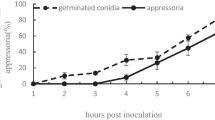Abstract
The arrival of rose rosette disease (RRD) in the Washington D.C. area prompted a transmission electron microscope study of ultrathin sections of leaves from symptomatic Rosa wichuraiana × safrano plants. Virus-like particles (VLPs) or double membrane-bound particles (DMPs) resembling those associated with RRD in other types of roses, and found in several other plant diseases, were seen in the cytoplasm of parenchymal and vascular bundle cells and shown, for the first time, in guard cells and budding into the vacuoles. Contrary to previous reports, starch granules were found in chloroplasts of the infected cells. A presumably unique intramitochondrial crystal was also observed. Variations in vacuolar content were noted.






Similar content being viewed by others
References
Ahn KK, Kim KS, Gergerich RC, Jensen SG, Anderson EJ (1996) Comparative ultrastructure of double membrane-bound particles and inclusions associated with eriophyid mite-borne plant diseases of unknown etiology: a potentially new group of plant viruses. J Submicrosc Cytol Pathol 28:345–355
Ahn KK, Kim KS, Gergerich RC, Jensen SG (1998) High plains disease of corn and wheat: ultrastructural and serological aspects. J Submicrosc Cytol Pathol 30:563–571
Amrine JW, Hindal DF (1988) Rose Rosette, a fatal disease of multiflora rose. WVa Agric Exp Stn Circ 147:1–4
Amrine JW, Hindal DF, Williams R, Appel J, Stasny T, Kassar A (1990) Rose Rosette as a biocontrol of multiflora rose. Proc South Weed Sci Soc 43:316–319
Asurmendi S, Berg RH, Koo JC, Beachy RN (2004) Coat protein regulates formulation of replication complexes during tobacco mosaic virus replication. Proc Natl Acad Sci USA 101:1415–1420
Connors IL (1941) Twentieth Annual Report of The Canadian Plant Disease Survey, 1940
Crowe FJ (1983) Witches’ broom of rose: a new outbreak in several central states. Plant Dis 67:544–546
Davis LE (1967) Intramitochondrial crystals in hydra. J Ultrastruct Res 21:125–133
Di R, Hill JH, Epstein AH (1990) Double-stranded DNA associated with the rose rosette disease of multiflora rose. Plant Dis 74:56–58
Doudrick RL (1984) Etiological studies of rose rosette. MSc thesis, University of Missouri, Columbia, Mo.
Eckardt N (1987) The nature conservancy element stewardship abstract for Rosa multiflora. http://tncweeds.ucdavis.edu/esadocs/documnts/rosamul.pdf
Epstein AH, Hill JH (1995) The biology of rose rosette disease: a mite-associated disease of uncertain aetiology. J Phytopathol 143:353–360
Epstein AH, Hill JH (1999) Status of rose rosette disease as a biological control for multiflora rose. Plant Dis 83:92–101
Epstein AH, Hill JH, Obrycki JJ (1993) Rose Rosette disease. Iowa State Univ Ext Publ No PM 1532, Ames, Iowa
Epstein AH, Hill JH, Nutter FW (1997) Augmentation of rose rosette disease for biocontrol of multiflora rose (Rosa multiflora). Weed Sci 45:175–178
Gergerich RC, Kim KS (1983) The causal agent of rose rosette disease in wild and cultivated roses in Arkansas. Ark Farm Res 32:7
Gibbons IR, Grimstone AV (1960) On flagellar structure in certain flagellates. J Biophys Biochem Cytol 7:697–716
Higgins A (2001) A mite-borne virus is taking the bloom off the rose. Washington Post, 13 September 2001, pp 1, 7
Hindal DF, Wong SM (1988) Potential biocontrol of multiflora rose, Rosa multiflora. Weed Technol 2:122–131
Hindal DF, Amrine JW, Williams RL, Stasny TA (1988) Rose Rosette disease on multiflora rose (Rosa multiflora) in Indiana and Kentucky. Weed Technol 2:442–444
Kim KS, Ahn KK, Gergerich RC (1995) Double membrane-bound virus-like particles associated with rose rosette and some other diseases transmitted by eriophyid mites. In: Proc Int Symp Rose Rosette. Iowa State University Press, Ames, pp 39–41
Luft JH (1961) Improvements in epoxy resin embedding methods. J Biophys Biochem Cytol 9:409–414
Osinchak J (1964) Electron microscopic localization of acid phosphatase and thymine pyrophosphate activity in hypothalamic neurosecretory cells of the rat. J Cell Biol 21:35–48
Peck A (2001) Rose Rosette—a web book
Richardson KC, Jarett L, Finke EH (1960) Embedding in epoxy resins for ultrathin sectioning in electron microscopy. Stain Technol 35:313–323
Rohozinski J, Epstein AH, Hill JH (2001) Probable mechanical transmission of a virus-like agent from rose rosette disease-infected multiflora rose to Nicotiana species. Ann Appl Biol 138:181–186
Sabatini DD, Bensch K, Barrnett RJ (1963) Cytochemistry and electron microscopy. The preservation of cellular ultrastructure and enzymatic activity by aldehyde fixation. J Cell Biol 178:19–58
Venable JH, Coggeshall R (1965) A simplified lead citrate stain for use in electron microscopy. J Cell Biol 25:407–408
Acknowledgements
We thank Sara Fisher for her patience and skill in typing this manuscript, Dr. R.C. Gergerich for her exemplary and collegial encouragement and for sharing her extensive knowledge of RRD with us, and Mrs. Maria J. Schoolman for allowing us to collect specimens of RRD in her garden.
Author information
Authors and Affiliations
Corresponding author
Additional information
Communicated by L.C. Fowke
Rights and permissions
About this article
Cite this article
Silvestro, S.R., Chapman, G.B. A transmission electron microscope study of “New Dawn” climber rose (Rosa wichuraiana × safrano) exhibiting rose rosette disease. Plant Cell Rep 23, 345–351 (2004). https://doi.org/10.1007/s00299-004-0838-3
Received:
Revised:
Accepted:
Published:
Issue Date:
DOI: https://doi.org/10.1007/s00299-004-0838-3




